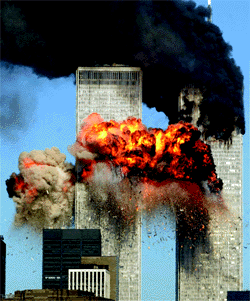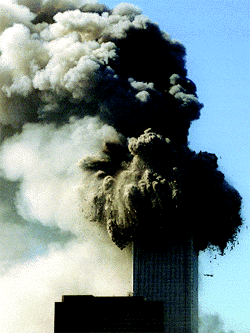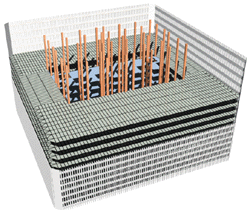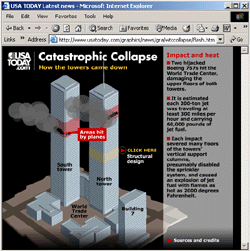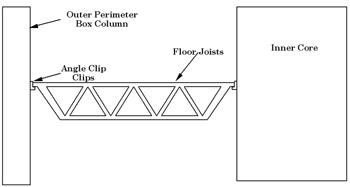Height: 1,368 and 1,362 feet (417 and 415 meters)
Owners: Port Authority of New York and New Jersey.
(99 year leased signed in April 2001 to groups including Westfield America and Silverstein Properties)
Architect: Minoru Yamasaki, Emery Roth and Sons consulting
Engineer: John Skilling and Leslie Robertson of Worthington, Skilling, Helle and Jackson
Ground Breaking: August 5, 1966
Opened: 1970-73; April 4, 1973 ribbon cutting
Destroyed: Terrorist attack, September 11, 2001
The Structural System
Yamasaki and engineers John Skilling and Les Robertson worked closely, and the relationship between the towers’ design and structure is clear. Faced with the difficulties of building to unprecedented heights, the engineers employed an innovative structural model: a rigid "hollow tube" of closely spaced steel columns with floor trusses extending across to a central core. The columns, finished with a silver-colored aluminum alloy, were 18 3/4" wide and set only 22" apart, making the towers appear from afar to have no windows at all.
Also unique to the engineering design were its core and elevator system. The twin towers were the first supertall buildings designed without any masonry. Worried that the intense air pressure created by the buildings’ high speed elevators might buckle conventional shafts, engineers designed a solution using a drywall system fixed to the reinforced steel core. For the elevators, to serve 110 stories with a traditional configuration would have required half the area of the lower stories be used for shaftways. Otis Elevators developed an express and local system, whereby passengers would change at "sky lobbies" on the 44th and 78th floors, halving the number of shaftways.
(Taken from www.skyscraper.org)
The structural system, deriving from the I.B.M. Building in Seattle, is impressively simple. The 208-foot wide facade is, in effect, a prefabricated steel lattice, with columns on 39-inch centers acting as wind bracing to resist all overturning forces; the central core takes only the gravity loads of the building. A very light, economical structure results by keeping the wind bracing in the most efficient place, the outside surface of the building, thus not transferring the forces through the floor membrane to the core, as in most curtain-wall structures. Office spaces will have no interior columns. In the upper floors there is as much as 40,000 square feet of office space per floor. The floor construction is of prefabricated trussed steel, only 33 inches in depth, that spans the full 60 feet to the core, and also acts as a diaphragm to stiffen the outside wall against lateral buckling forces from wind-load pressures."
Taken from www.greatbuildings.com
Typical Floor Plan of the World Trade Center
A perimeter of closely spaced columns, with an internal lift core. The floors were supported by a series of light trusses on rubber pads, which spanned between the outer columns and the lift core.
Why Did It Collapse?
Tim Wilkinson, Lecturer in Civil Engineering
(This is an initial suggestion, originally written on Sept 11 2001 (with some minor subsequent changes) on one possible reason for failure, and should not be regarded as official advice.)
The structural integrity of the World Trade Center depends on the closely spaced columns around the perimeter. Lightweight steel trusses span between the central elevator core and the perimeter columns on each floor. These trusses support the concrete slab of each floor and tie the perimeter columns to the core, preventing the columns from buckling outwards.
After the initial plane impacts, it appeared to most observers that the structures had been severely damaged, but not necessarily fatally.
It appears likely that the impact of the plane crash destroyed a significant number of perimeter columns on several floors of the building, severely weakening the entire system. Initially this was not enough to cause collapse.
However, as fire raged in the upper floors, the heat would have been gradually affecting the behaviour of the remaining material. As the planes had only recently taken off, the fire would have been initially fuelled by large volumes of jet fuel, which then ignited any combustible material in the building. While the fire would not have been hot enough to melt any of the steel, the strength of the steel drops markedly with prolonged exposure to fire, while the elastic modulus of the steel reduces (stiffness drops), increasing deflections.
Modern structures are designed to resist fire for a specific length of time. Safety features such as fire retarding materials and sprinkler systems help to contain fires, help extinguish flames, or prevent steel from being exposed to excessively high temperatures. This gives occupants time to escape and allow fire fighters to extinguish blazes, before the building is catastrophically damaged.
It is possible that the blaze, started by jet fuel and then engulfing the contents of the offices, in a highly confined area, generated fire conditions significantly more severe than those anticipated in a typical office fire. These conditions may have overcome the building's fire defences considerably faster than expected. It is likely that the water pipes that supplied the fire sprinklers were severed by the plane impact, and much of the fire protective material, designed to stop the steel from being heated and losing strength, was blown off by the blast at impact.
Eventually, the loss of strength and stiffness of the materials resulting from the fire, combined with the initial impact damage, would have caused a failure of the truss system supporting a floor, or the remaining perimeter columns, or even the internal core, or some combination. Failure of the flooring system would have subsequently allowed the perimeter columns to buckle outwards. Regardless of which of these possibilities actually occurred, it would have resulted in the complete collapse of at least one complete storey at the level of impact.
Once one storey collapsed all floors above would have begun to fall. The huge mass of falling structure would gain momentum, crushing the structurally intact floors below, resulting in catastrophic failure of the entire structure. While the columns at say level 50 were designed to carry the static load of 50 floors above, once one floor collapsed and the floors above started to fall, the dynamic load of 50 storeys above is very much greater, and the columns at each level were almost instantly destroyed as the huge upper mass fell to the ground.
(US readers note: storey is the Australian/English spelling of story)
Sydney Morning Herald graphic adapted from the information on this page.
When this article was first written on 9/11, the only evidence Was photographs and television footage. Whether failure was initiated at the perimeter columns or the core is unknown. The extent to which the internal parts were damaged during the collision may be evident in the rubble if any forensic investigation is conducted. Since the mass of the combined towers is close to 1000000 tons, finding evidence will be an enormous task.
Perimeter columns, several storeys high, and still linked together, lie amongst all the debris on the ground.
This photograph shows the south tower just as it is collapsing. It is evident that the building is falling over to the left. The North Tower collapsed directly downwards, on top of itself. The same mechanism of failure, the combination of impact and subsequent fire damage, is the likely cause of failure of both towers. However, it is possible that a storey on only one side of the South Tower initially collapsed, resulting in the "skewed" failure of the entire tower.
While the ways the two towers fell were slightly different, the basic cause is similar for both - a large number of columns were destroyed on impact, and the remaining structure was gradually weakened by the heat of the fire. Not much significance should be taken from the fact that one tower fell in 45 minutes and the other in 90 minutes.
The gigantic dynamic impact forces caused by the huge mass of the falling structure landing on the floors below is very much greater than the static load they were designed to resist.
Other Theories?
This section added 14 January 2006
This website generates many queries from people in response to some of the other theories that are put forward relating to the collapse - namely that it was a controlled explosion.
The initial impact/further weakening by fire reasoning is based on uncontestable knowledge about the behaviour of structures in general, and the weakening of steel under fire conditions, plus video footage of the events and examination of the steel afterwards. The official FEMA report written by engineering experts came to this conclusion based on the evidence.
However, should additional evidence come to light that supports a different theory, the author is willing to reassess his views.
The fire wasn't hot enough to melt the steel
There has never been a claim that the steel melted in the fire before the buildings collapsed, however the fire would have been very hot. Even though the steel didnt melt, the type of temperatures in the fire would have roughly halved its strength.
There would have been variations in the distribution of the temperature both in place in time. There are photos that show people in the areas opened up by the impact, so it obviously wasnt too hot when those photos were taken, but this is not to say that other parts of the building, further inside were not hotter. In addition, to make a reasonable conclusion from these photos, it would be important to know when they were taken. It might be possible that just after the impact the area wasnt very hot, but as the fire took hold the area got hotter.
The way the building collapsed must have been caused by explosions
One demolition expert on the day of the collapse said it looked like implosion but this is not very strong evidence. Implosion firstly requires a lot of explosives placed in strategic areas all around the building. When and how was this explosive placed in the building without anyone knowing about it. Second, implosion required more than just explosives. Demolition experts spend weeks inside a derelict building planning an event. Many of the beams are cut through by about 90% so that the explosion only has to break a small bit of steel. In this state the building is highly dangerous, and there is no way such a prepared building could still be running day to day like WTC was.
Why did the building fall so quickly?
The buildings did fall quickly - almost (but not exactly) at the same speed as if there was no resistance. Shouldn't the floors below have slowed it down? The huge dynamic loads due to the very large momentum of the upper floors falling were so great that they smashed through the lower floors very quickly. The columns were not designed to carry these huge loads and they provided little resistance.
What about World Trade Center 7?
I have not studied WTC in any great detail and cannot offer any theories on its collapse mechanism. In the chaos of the day, little attention was paid to WTC7, so there is less evidence available on the damage it sustained before it collapsed. However, some questions that you may want to ponder ...
* While it did not receive any direct impact form the planes, how much debris hit at as the main towers collapsed and what damage did it cause?
* To what extent (if any) did the shock or vibrations caused by the collapse of WTC1 & 2 affect the integrity of WTC7?
* Did any unseen damage to the WTC7 foundations occur in the collapse of WTC 1 & 2?
* Did any of the fire suppression systems in WTC7 function?
The author respect people's right to question theories, but at the present time the author does not believe there is enough evidence for him to change his views on this incident.


















